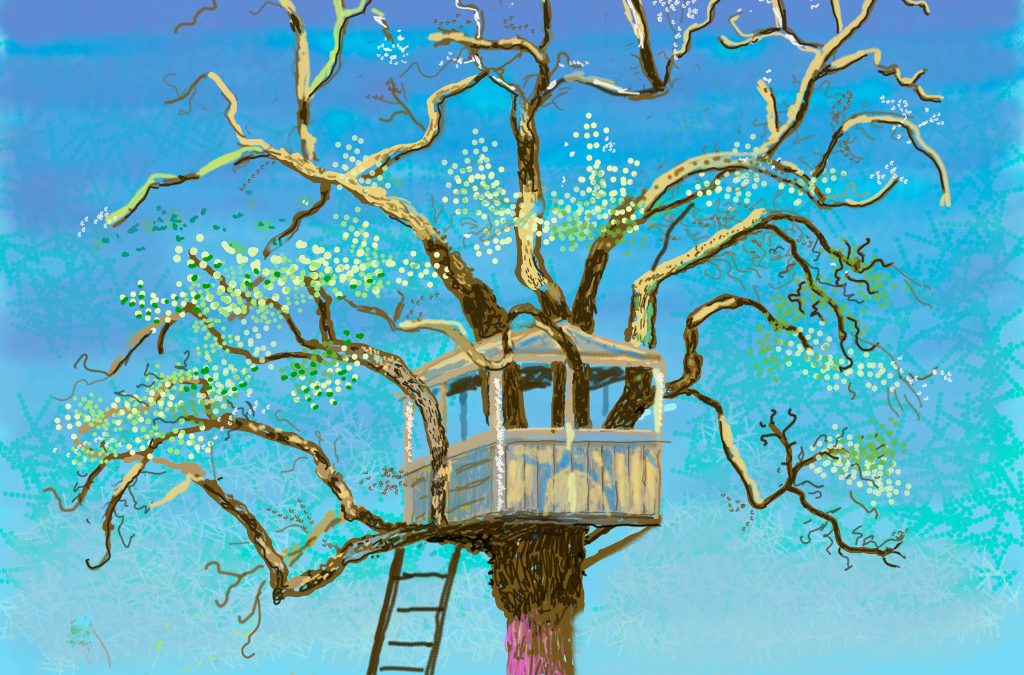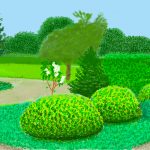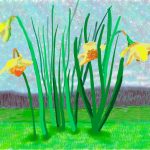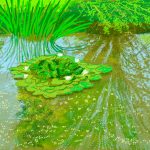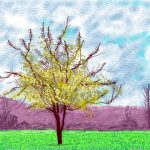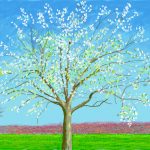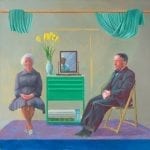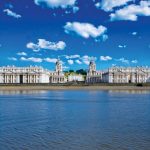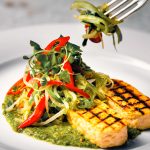Mark Bibby Jackson visits The Arrival of Spring by David Hockney, and is struck by how wonderfully light the exhibition is, compared with the all-enveloping darkness that has preceded it.
The first thing I notice upon entering David Hockney’s The Arrival of Spring at the Royal Academy of Arts is the brightness of the room. Light spills through the windows at the top of the exhibition halls and flows onto the paintings. After so much darkness during the past year and a half it is a most blessed relief.
The Arrival of Spring
The Arrival of Spring is a series of paintings created by Hockney while staying in Normandy between February and June 2020, just as the first lockdown was being imposed. So it seems appropriate for this to be the first exhibition to open at the Royal Academy – along with Michael Armitage’s Paradise Edict once the third, and hopefully last, lockdown has been lifted.
One of the remarkable feature of this series of 116 works is that they have been created on the artist’s iPad. This has allowed him to work in the open air and produce a new painting each day as he charts the arrival of spring in his small plot of land in Northern France.
“I realised to show the full arrival of spring, you have to start in the winter and go into the summer a bit, and then you see all the differences and all the rich things that happen to each tree,” Hockney explains in an interview with Edith Delaney, Curator of Contemporary Projects at the Royal Academy of Arts, who curated the show. “It can’t be done in one painting.”
Hockney also explains that the lockdown enabled him to focus on the series of paintings.
“When the lockdown came… we were in a house in the middle of a four-acre field full of fruit trees. I could concentrate on one thing, I did at least one drawing a day with the constant changes going on, all around the house,” he says.
The chronological structuring of the exhibition enables us to chart the arrival of spring, just as Hockney does. It also allows you to see how the artist’s skill with the iPad develops.
“I kept drawing the winter trees, and then the small buds that became the blossom, and then the full blossom,” he says. “Then the leaves started, and eventually the blossom fell off leaving a small fruit and leaves, this process took about two weeks, all the time I was getting better at my mark making on the screen, eventually doing, à la Monet, the water lilies in the pond.”
Perfecting His i-Technique
This is not the first time that Hockney has charted the arrival of Spring in a series of paintings created on his iPad. In 2011, he charted the same natural process in his native Yorkshire, which was exhibited in A Bigger Picture at the Royal Academy the following year. However this time Hockney has used a new app that has been adapted to his technique.
“Now, I’m really painting on the iPad, because I’m using layers a lot more, I’m using new, little brushes that I got them to make for me, little shapes and thing, and I feel I’m painting,” he tells Delaney.
The result is a most wonderful celebration of the arrival of spring. As you wander around the rooms, you almost feel as if the season is unfolding before you. It really is a most welcome vaccine against the darkness of the preceding few months.
The setting in Normandy is appropriate. The smallholding is close to Giverny where Monet studied the spring each year. Certainly there is more than a hint of French Impressionism in Hockney’s paintings.
The only drawback with Hockney’s new technique is that the paintings inevitably lack texture – something that is highlighted when you visit Armitage’s highly textured exhibition just across the halls of the RA. However for me, this is a small price to pay for such an expansive body of work.
The Arrival of Spring might well inspire you to travel to Normandy and watch the seasonal change at close hand, once international travel has opened again. Let’s hope so.
David Hockney : The Arrival of Spring
Royal Academy of Arts 23 May to 26 September, 2021 (10am to 6pm, last admission 5:30pm). Closed Mondays. Main Galleries (Galleries 2, 3, Central Hall and Lecture Room) to 1 August, then The Gabrielle Jungels-Winkler Galleries from 11 August to 26 September.
Tickets from £17. Under 16s and Friends of the RA free (T&Cs apply). Advanced booking is essential. All visitors must have a pre-booked timed ticket.
For Further Information on the Exhibition
Contact: royalacademy.org.uk or call 0207 300 8090. Main image: David Hockney, “No. 125”, 19th March 2020
iPad painting, © David Hockney.
